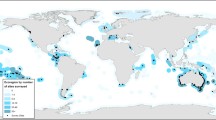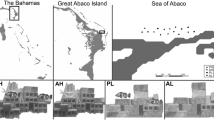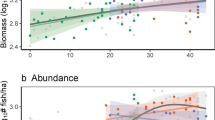Abstract
Reef fish species naturally fluctuate in abundance over various temporal and spatial scales, but recent broad-scale declines in abundance have been observed worldwide and attributed to various anthropogenic influences. We used 25 years of fishery-independent trap data (N = 11,237 trap hauls) to examine the spatial and temporal variability in temperate reef fish abundance along the southeast coast of the USA, a relatively understudied region with many economically important reef fish species. Overall, 441,298 individuals from 118 species were caught in the trap survey. Number of species and total number of individuals caught in the trap survey declined over the 25 years, but when separated, nontargeted fish species declined more than fishery-targeted species. For instance, traps caught a median of 18 nontargeted individuals and a median of 2–3 nontargeted reef fish species in the early 1990s, but by the 2010s, traps caught a median of fewer than three nontargeted individuals and a median of one nontarget species. Using generalized additive models, we found that the catch of fishery-targeted and nontargeted species was positively related to bottom water temperature, while depth influenced nontargeted and fishery-targeted species in opposite ways. The substantial and consistent decline in nontargeted fish species suggests that more research and management attention should be given to these often ignored species. These results suggest that the temperate reef fish community in the southeast USA is influenced by more than just fishing, perhaps including invasive species (e.g., lionfish Pterois volitans), decadal-scale environmental variability, or climate change.







Similar content being viewed by others
References
Bacheler NM, Buckel JA (2004) Does hook type influence the catch rate, size, and injury of grouper in a North Carolina commercial fishery? Fish Res 69:303–311
Bacheler NM, Bailey KM, Ciannelli L, Bartolino V, Chan KS (2009) Density-dependent, landscape, and climate effects on spawning distribution of walleye pollock Theragra chalcogramma. Mar Ecol Prog Ser 391:1–12
Bacheler NM, Bartolino V, Reichert MJM (2013a) Influence of soak time and fish accumulation on catches of reef fishes in a multispecies trap survey. Fish Bull 111:218–232
Bacheler NM, Schobernd ZH, Berrane DJ, Schobernd CM, Mitchell WA, Geraldi NR (2013b) When a trap is not a trap: converging entry and exit rates and their effect on trap saturation of black sea bass (Centropristis striata). ICES J Mar Sci 70:873–882
Bacheler NM, Schobernd CM, Schobernd ZH, Mitchell WA, Berrane DJ, Kellison GT, Reichert MJM (2013c) Comparison of trap and underwater video gears for indexing reef fish presence and abundance in the southeast United States. Fish Res 143:81–88
Bacheler NM, Berrane DJ, Mitchell WA, Schobernd CM, Schobernd SH, Teer BZ, Ballenger JC (2014) Environmental conditions and habitat characteristics influence trap and video detection probabilities for reef fish species. Mar Ecol Prog Ser 517:1–14
Bartolino V, Ciannelli L, Bacheler NM, Chan KS (2012) Ontogeny and sex disentangle density-dependent and density-independent spatiotemporal dynamics of a marine fish population. Ecology 92:189–200
Bell RJ, Richardson DE, Hare JA, Lynch PD, Fratantoni PS (2015) Disentangling the effects of climate, abundance, and size on the distribution of marine fish: an example based on four stocks from the Northeast US shelf. ICES J Mar Sci 72:1311–1322
Bellwood DR, Hughes TP, Folke C, Nyström M (2004) Confronting the coral reef crisis. Nature 429:827–833
Berg Å, Tjernberg M (1996) Common and rare Swedish vertebrates—distribution and habitat preferences. Biodivers Conserv 5:101–128
Boulinier T, Nichols JD, Sauer JR, Hines JE, Pollock KH (1998) Estimating species richness: the importance of heterogeneity in species detectability. Ecology 79:1018–1028
Bunge J, Fitzpatrick M (1993) Estimating the number of species: a review. J Am Stat Assoc 88:364–373
Burnham KP, Anderson DR (2002) Model selection and multimodal inference: a practical information-theoretic approach, 2nd edn. Springer, New York
Cadrin SX, Secor DH (2009) Accounting for spatial population structure in stock assessment: past, present, and future. In: Rothschild BJ, Beamish R (eds) The future of fishery science in North America. Springer, New York, pp 405–426
Christensen V, Coll M, Piroddi C, Steenbeek J, Buszowski J, Pauly D (2014) A century of fish biomass decline in the ocean. Mar Ecol Prog Ser 512:155–166
Ciannelli L, Bartolino V, Chan KS (2012) Non-additive and non-stationary properties in the spatial distribution of a large marine fish population. Proc R Soc B 279:3635–3642
Ciannelli L, Fisher JAD, Skern-Mauritzen M, Hunsicker ME, Hidalgo M, Frank KT, Bailey KM (2013) Theory, consequences and evidence of eroding population spatial structure in harvested marine fish: a review. Mar Ecol Prog Ser 480:227–243
Coggins LG Jr, Bacheler NM, Gwinn DC (2014) Occupancy models for monitoring marine fish: a Bayesian hierarchical approach to model imperfect detection with a novel gear combination. PLoS ONE 9:e108302. doi:10.1371/journal.pone.0108302
Coleman FC, Koenig CC, Huntsman GR, Musick JA, Eklund AM, McGovern JC, Chapman RC, Sedberry GR, Grimes CB (2000) Long-lived reef fishes: the grouper-snapper complex. Fisheries 25:14–20
Coll M, Santojanni A, Palomera I, Arneri E (2009) Food-web changes in the Adriatic Sea over the last three decades. Mar Ecol Prog Ser 381:17–37
Collins MR (1990) A comparison of three fish trap designs. Fish Res 9:325–332
Cushing DH (1990) Plankton production and year-class strength in fish populations: an update of the match-mismatch hypothesis. Adv Mar Biol 26:249–293
Dunning JB, Danielson BJ, Pulliam RH (1992) Ecological processes that affect populations in complex landscapes. Oikos 65:169–175
Frank KT, Petrie B, Shackell NL (2007) The ups and downs of trophic control in continental shelf ecosystems. Trends Ecol Evol 22:236–242
Gaston KJ (1994) Rarity. Chapman & Hall, London
Gotelli NJ, Colwell RK (2001) Quantifying biodiversity: procedures and pitfalls in the measurement and comparison of species richness. Ecol Lett 4:379–391
Gotelli NJ, Dorazio RM, Ellison AM, Grossman GD (2010) Detecting temporal trends in species assemblages with bootstrapping procedures and hierarchical models. Philos Trans R Soc B 365:3621–3631
Hastie TJ, Tibshirani RJ (1990) Generalized additive models. Chapman & Hall, New York
Hughes TP, Baird AH, Bellwood DR et al (2003) Climate change, human impacts, and the resilience of coral reefs. Science 301:929–933
Hutchings JA, Baum JK (2005) Measuring marine fish biodiversity: temporal changes in abundance, life history and demography. Philos Trans R Soc B 360:315–338
Hyun KH, He R (2010) Coastal upwelling in the South Atlantic Bight: a revisit of the 2003 cold event using long term observations and model hindcast solutions. J Mar Syst 83:1–13
Iles TD, Sinclair M (1982) Atlantic herring: stock discreteness and abundance. Science 215:627–633
Jennings S, Greenstreet SPR, Hill L, Piet GJ, Pinnegar JK, Warr KJ (2002) Long-term trends in the trophic structure of the North Sea fish community: evidence from stable-isotope analysis, size-spectra and community metrics. Mar Biol 141:1085–1097
Kellison GT, McDonough V, Harper DE, Tilmant JT (2012) Coral reef assemblage shifts and declines in Biscayne National Park, Florida, USA. Bull Mar Sci 88:147–182
Kenchington TJ, Kenchington ELR (2013) Biodiversity metrics for use in the ecosystem approach to ocean management. Canadian Technical Report of Fisheries and Aquatic Sciences 3059. Fisheries and Oceans, Dartmouth
Kendall MS, Bauer LJ, Jeffrey CFG (2008) Influence of benthic features and fishing pressure on size and distribution of three exploited reef fishes from the southeastern United States. Trans Am Fish Soc 137:1134–1146
Kimura DK, Somerton DA (2006) Review of statistical aspects of survey sampling for marine fisheries. Rev Fish Sci 14:245–283
Kirby RR, Beaugrand G, Lindley JA (2009) Synergistic effects of climate and fishing in a marine ecosystem. Ecosystems 12:548–561
Lekve K, Boulinier T, Stenseth NC, Gjøsæter FJ, Hines JE, Nichols JD (2002) Spatio-temporal dynamics of species richness in coastal fish communities. Proc R Soc Lond B 269:1781–1789
Lennon JJ, Koleff P, Greenwood JJD, Gaston KJ (2004) Contribution of rarity and commonness to patterns of species richness. Ecol Lett 7:81–87
Lesser MP, Slattery M (2011) Phase shift to algal dominated communities at mesophotic depths associated with lionfish (Pterois volitans) invasion on a Bahamian coral reef. Biol Invasions 13:1855–1868
MacKenzie BR, Köster FW (2004) Fish production and climate: sprat in the Baltic Sea. Ecology 85:784–794
MacKenzie DI, Nichols JD, Lachman GB, Droege S, Royle JA, Langtimm CA (2002) Estimating site occupancy rates when detection probabilities are less than one. Ecology 83:2248–2255
Maunder MN, Punt AE (2004) Standardizing catch and effort data: a review of recent approaches. Fish Res 70:141–159
McGovern JC, Sedberry GR, Harris PJ (1998) The status of reef fish stocks off the Southeast United States, 1983–1996. Proc Gulf Caribb Fish Inst 50:871–895
Mitchell WA, Kellison GT, Bacheler NM, Potts JC, Schobernd CM, Hale LF (2014) Depth-related distribution of postjuvenile red snapper in southeastern U.S. Atlantic Ocean waters: ontogenic patterns and implications for management. Mar Coast Fish 6:142–155
Munday PL, Jones GP, Pratchett MS, Williams AJ (2008) Climate change and the future of coral reef fishes. Fish Fish 9:261–285
Muñoz RC, Currin CA, Whitfield PE (2011) Diet of invasive lionfish on hard bottom reefs of the Southeast USA: insights from stomach contents and stable isotopes. Mar Ecol Prog Ser 432:181–193
Murphy HM, Jenkins GP (2010) Observational methods used in marine spatial monitoring of fishes and associated habitats: a review. Mar Freshw Res 61:236–252
Neter J, Wasserman W, Kutner MH (1989) Applied linear regression models, 2nd edn. Irwin, Homewood
Paddack MJ, Reynolds JD et al (2009) Recent region-wide declines in Caribbean reef fish abundance. Curr Biol 19:590–595
Pandolfi JM, Bradbury RH et al (2003) Global trajectories of the long-term decline of coral reef ecosystems. Science 301:955–958
Parker RO Jr, Dixon RL (1998) Changes in a North Carolina reef fish community after 15 years of intense fishing—global warming implications. Trans Am Fish Soc 127:908–920
Parrish JD (1987) The trophic biology of snapper and groupers. In: Polovina JJ, Ralston S (eds) Tropical snappers and groupers: biology and fisheries management. Westview, Boulder, pp 405–463
Powles H, Barans CA (1980) Groundfish monitoring in sponge-coral areas off the southeastern United States. Mar Fish Rev 42:21–35
Rogers SI, Ellis JR (2000) Changes in the demersal fish assemblages of British coastal waters during the 20th century. ICES J Mar Sci 57:866–881
Rudershausen PJ, Williams EH, Buckel JA, Potts JC, Manooch CS III (2008) Comparison of reef fish catch per unit effort and total mortality between the 1970s and 2005–2006 in Onslow Bay, North Carolina. Trans Am Fish Soc 137:1389–1405
Schobernd CM, Sedberry GR (2009) Shelf-edge and upper-slope reef fish assemblages in the South Atlantic Bight: habitat characteristics, spatial variation, and reproductive behavior. Bull Mar Sci 84:67–92
Sedberry GR, Van Dolah RF (1984) Demersal fish assemblages associated with hard bottom habitat in the South Atlantic Bight of the U.S.A. Environ Biol Fish 11:241–258
Semmens BX, Ruesink JL, Pattengill-Semmens CV (2000) Estimating multi-species trends in reef fishes from a large volunteer generated data set: a new tool for management. In: Proceedings of the 9th international coral reef symposium, vol 2, pp 1071–1078
Shertzer KW, Williams EH, Taylor JC (2009) Spatial structure and temporal patterns in a large marine ecosystem: exploited reef fishes of the southeast United States. Fish Res 100:126–133
Stratton M (2011) An ecosystem perspective: temporal analyses of the reef fish assemblage in southeast U.S. Atlantic continental shelf waters. Master thesis, College of Charleston, South Carolina
R Core Team (2014) R: a language and environment for statistical computing. R Foundation for Statistical Computing, Vienna. http://www.r-project.org/. Accessed 11 June 2015
Walters CJ, Martell SJD (2004) Fisheries ecology and management. Princeton University Press, Princeton
Winfree R, Fox JW, Williams NM, Reilly JR, Cariveau DP (2015) Abundance of common species, not species richness, drives delivery of real-world ecosystem services. Ecol Lett 18:626–635
Wood SN (2006) Generalized additive models: an introduction with R. Chapman & Hall/CRC, Boca Raton
Wood SN (2011) Fast stable restricted maximum likelihood for marginal likelihood estimation of semiparametric generalized linear models. J R Stat Soc B Stat Methodol 73:3–36
Wood RJ, Austin HM (2009) Synchronous multidecadal fish recruitment patterns in Chesapeake Bay, USA. Can J Fish Aquat Sci 66:496–508
Wyanski DM, White DB, Barans CA (2000) Growth, population age structure, and aspects of the reproductive biology of snowy grouper, Epinephelus niveatus, off North Carolina and South Carolina. Fish Bull 98:199–212
Zhao J, Cao J, Tian S, Chen Y, Zhang S, Wang Z, Zhou X (2014) A comparison between two GAM models in quantifying relationships of environmental variables with fish richness and diversity indices. Aquat Ecol 48:297–312
Zuur AF, Savaliev AA, Ieno EN (2012) Zero inflated models and generalized linear mixed models with R. Highland Statistics, Newburgh
Acknowledgments
We thank the captains and crews of the RV Palmetto, RV Savannah, NOAA Ship Pisces, and NOAA Ship Nancy Foster, SERFS staff, and numerous volunteers for making field work possible. We thank N. Ballew, A. Hohn, T. Kellison, P. Marraro, K. Shertzer, and two reviewers for providing comments on earlier versions of this manuscript. This work was funded by the National Marine Fisheries Service. Data collection for this study was allowed through various Scientific Research Permits, and research followed the guidelines of the US Government Principles for the Utilization and Care of Vertebrate Animals Used in Testing, Research, and Training (http://grants.nih.gov/grants/olaw/references/phspol.htm#USGovPrinciples). This article does not contain any studies with human participants performed by any of the authors. The views and opinions expressed or implied in this article are those of the authors and do not necessarily reflect the position of the National Marine Fisheries Service, NOAA.
Author information
Authors and Affiliations
Corresponding author
Ethics declarations
Conflict of interest
The authors declare that they have no conflict of interest.
Additional information
Responsible Editor: K. Clements.
Reviewed by undisclosed experts.
Rights and permissions
About this article
Cite this article
Bacheler, N.M., Smart, T.I. Multi-decadal decline in reef fish abundance and species richness in the southeast USA assessed by standardized trap catches. Mar Biol 163, 26 (2016). https://doi.org/10.1007/s00227-015-2774-x
Received:
Accepted:
Published:
DOI: https://doi.org/10.1007/s00227-015-2774-x




